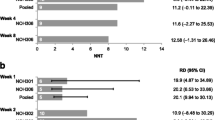Abstract
This study was designed to determine the efficacy and tolerability of increasing doses ofl-threo-dihydroxyphenylserine (l-threo-DOPS) in treating symptomatic orthostatic hypotension associated with multiple system atrophy (MSA) and pure autonomic failure (PAF). Following a one-week run-in, patients (26 MSA; 6 PAF) with symptomatic orthostatic hypotension received increasing doses ofl-threo-DOPS (100, 200 and 300 mg, twice daily) in an open, dose-ranging study. Incremental dose adjustment (after weeks two and four of outpatient treatment) was based on clinical need until blood pressure (BP), and symptoms improved. Final dosage was maintained for six weeks. Withl-threo-DOPS, systolic BP decrease was reduced during orthostatic challenge (−22±28 mm Hg reduction from a baseline decrease of 54.3±27.7 mm Hg, p=0.0001, n=32; supine systolic BP at final visit was 118.9±28.2 mm Hg). By the end of the study, 25 patients (78%) improved, and in 14 patients (44%) orthostatic hypotension was no longer observed. Decreased orthostatic systolic BP decrease occurred in 22% (7/32), 24% (6/25) and 61% (11/18) of patients treated with 100, 200, and 300 mgl-threo-DOPS twice daily, respectively. An improvement occurred in symptoms associated with orthostatic hypotension, such as light-headedness, dizziness (p=0.0125), and blurred vision (p=0.0290).l-threo-DOPS was well tolerated, with the 2 serious adverse events reported being a possible complication of the disease under study, and with no reports of supine hypertension. I conclusion,l-threo-DOPS (100, 200, and 300 mg, twice daily) was well tolerated. The dosage of 300 mg twice dailyl-threo-DOPS seemed to offer the most effective control of symptomatic orthostatic hypotension in MSA and PAF.
Similar content being viewed by others
References
Mathias CJ. Disorders of the autonomic nervous system. In:Neurology in clinical practice. 3rd ed. Bradley WG, Daroff RB, Fenichel GM, et al., eds. Boston: Butterworth Heinemann; 2000. pp. 2131–2165.
Luukinen H, Herala M, Koski K, et al. Rapid increase of fall-related severe head injuries with age among older people: a population-based study.J Am Geriatr Soc 1999; 47(12):1451–1452.
Mathias CJ, Kimber JR. Postural hypotension: causes, clinical features, investigation and management.Annu Rev Med 1999; 50:317–336.
Kaufmann H. Could treatment with DOPS do for autonomic failure what DOPA did for Parkinson's disease?Neurology 1996; 47:1370–1371.
Mathias CJ and Bannister R. Dopamine beta-hydroxylase deficiency. InAutonomic failure. A textbook of clinical disorders of the autonomic nervous system, 4th ed. Mathias CJ, Bannister R, eds. Oxford and New York: Oxford University Press; 1999. pp. 387–401.
Suzuki T, Azuma T, Araki S, et al. Treatment of autonomic dysfunction with L-threo-3-4-dihydroxyphenylserine (L-DOPS) in patients with familial amyloidotic polyneuropathy: A multicentre study. In:Amyloid and amyloidosis. Isobe T, Araki S, Uchino F, et al., eds. New York and London: Plenum Press; 1988. pp. 851–856.
Carvalho MJ, van den Meiracker AH, Boomsma F, et al. Improved orthostatic tolerance in familial amyloidotic polyneuropathy with unnatural noradrenaline precursor L-threo-3,4-dihydrophenylserine.J Auton Nerv Syst 1997; 62:63–71.
Sobue I, Senda Y, Hirayama K, et al. Clinical pharmacological evaluation of L-threo-3-4-dihydroxyphenylserine (L-DOPS) in Shy-Drager's syndrome and its related diseases. A nation-wide double-blind comparative study.Jpn J Clin Exp Med 1987; 141:353–378.
Freeman R, Landsberg L, Young J. The treatment of neurogenic orthostatic hypotension with 3,4-DL-threo-dihydroxyphenylserine: a randomised, placebo-controlled, crossover trial.Neurology 1999; 53(9):2151–2157.
Narabayashi H, Nakanishi T. Therapeutic effects of L-DOPS in Parkinson's disease, double-blind comparative study against placebo as control in patients with long-term levodopa therapy.Clin Eval 1987; 15:423–457.
May CN, Ham IW, Heslop K, et al. Intravenous morphine causes hypertension, hyperglycaemia and increases sympatho-adrenal activity in the conscious rabbit.Clin Sci 1988; 75:71–77.
Suzuki T, Higa S, Sakoda S, et al. Pharmacokinetic studies of oral L-threo-3,4-dihydroxyphenylserine in normal subjects and patients with familial amyloid polyneuropathy.Eur J Clin Pharmacol 1982; 23:463–468.
Committee for Proprietary Medicinal Products. Points to consider on missing data.CPMP/EWP/1776/99 draft. London, January 25, 2001.
Mathias CJ, Mallipeddi R, Bleasdale-Barr K. Symptoms associated with orthostatic hypotension in pure autonomic failure and multiple system atrophy.J Neurol 1999; 246(10):893–898.
Kachi T, Iwase S, Mano T, et al. Effect of L-threo-3,4-dihydroxyphenylserine on muscle sympathetic nerve activity in Shy-Drager syndrome.Neurology 1988; 38:1091–1094.
Mathias CJ. Autonomic disorders and their recognition.N Engl J Med 1997; 10:721–724.
Low PA, Gilden JL, Freeman R, et al. for the Midodrine Study Group. Efficacy of midodrine vs placebo in neurogenic orthostatic hypotension.JAMA 1997; 277(13):1046–51.
Author information
Authors and Affiliations
Corresponding author
Additional information
The study was supported by Sumitomo Pharmaceuticals Europe, London, U.K.
Rights and permissions
About this article
Cite this article
Mathias, C.J., Senard, JM., Braune, S. et al. l-threo-dihydroxyphenylserine (l-threo-DOPS; droxidopa) in the management of neurogenic orthostatic hypotension: A multi-national, multi-center, dose-ranging study in multiple system atrophy and pure autonomic failure. Clinical Autonomic Research 11, 235–242 (2001). https://doi.org/10.1007/BF02298955
Received:
Accepted:
Issue Date:
DOI: https://doi.org/10.1007/BF02298955




